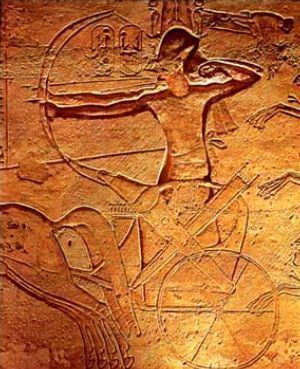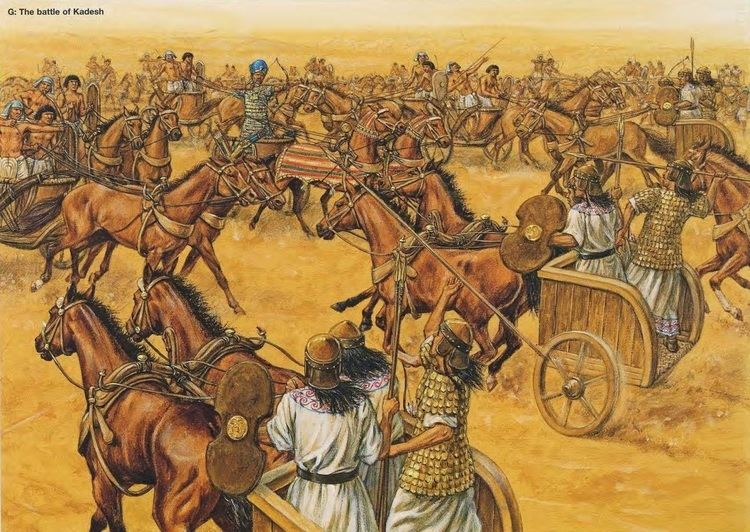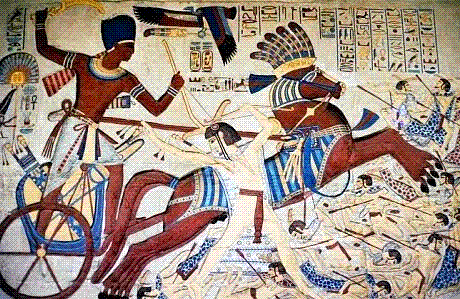Unknown Unknown | Date 1274 BC | |
 | ||
20,000 men(half engaged)16,000 infantry2,000 chariots4,000 men Somewhere between 23,000–50,000 menSomewhere between 15,000–40,000 infantry(not engaged)Somewhere between 2,500–3,700 chariotsSomewhere between 9,000–11,100 men Result Egyptian tactical victory, strategically indecisive. Negotiated peace treaty Similar Battle of Megiddo (15th cent, Battle of Megiddo, Battle of Gaugamela, Battle of Cannae, Battle of Marathon | ||
Robert ritner theo van den hout the battle of kadesh a debate
The Battle of Kadesh or Battle of Qadesh took place between the forces of the Egyptian Empire under Ramesses II and the Hittite Empire under Muwatalli II at the city of Kadesh on the Orontes River, just upstream of Lake Homs near the modern Syrian-Lebanese border.
Contents
- Robert ritner theo van den hout the battle of kadesh a debate
- Todesbonden battle of kadesh
- Background
- Kadesh campaign
- Contending forces
- Battle
- Aftermath
- Documentation
- Hittite allies
- Hittite fallen
- References

The battle is generally dated to 1274 BC in the conventional Egyptian chronology, and is the earliest battle in recorded history for which details of tactics and formations are known. It is believed to have been the largest chariot battle ever fought, involving between 5,000 and 6,000 chariots in total.

As a result of the multiple Kadesh inscriptions, it is the best documented battle in all of ancient history.

Todesbonden battle of kadesh
Background

After expelling the Hyksos 15th dynasty around 1550 BC, the native Egyptian New Kingdom rulers became more aggressive in reclaiming control of their state's borders. Thutmose I, Thutmose III and his son and coregent Amenhotep II fought battles from Megiddo north to the Orontes River, including conflict with Kadesh.

Many of the Egyptian campaign accounts between c. 1400 and 1300 BC reflect the general destabilization of the region of the Djahi (Southern Canaan). The reigns of Thutmose IV and Amenhotep III were undistinguished, except that Egypt continued to lose territory to Mitanni in northern Syria.
During the late Egyptian 18th dynasty, the Amarna Letters tell the story of the decline of Egyptian influence in the region. The Egyptians showed flagging interest here until almost the end of the dynasty. Horemheb (d 1292 BC), the last ruler of this dynasty, campaigned in this region, finally beginning to turn Egyptian interest back to this region.
This process continued in the 19th Dynasty. Like his father Ramesses I, Seti I was a military commander and set out to restore Egypt's empire to the days of the Tuthmosis kings almost a century before. Inscriptions on Karnak temple walls record the details of his campaigns into Canaan and Syria. He took 20,000 men and reoccupied abandoned Egyptian posts and garrisoned cities. He made an informal peace with the Hittites, took control of coastal areas along the Mediterranean, and continued to campaign in Canaan. A second campaign led to his capture of Kadesh (where a stela commemorated his victory) and Amurru. His son and heir Ramesses II campaigned with him. There are historical records that record a large weapons order by Ramesses II in the year prior to the expedition he led to Kadesh in his fifth regnal year.
However, at some point, both regions may have lapsed back into Hittite control. What exactly happened to Amurru is disputed. The Hittitologist Trevor Bryce suggests that, although it may have fallen once again under Hittite control, it is more likely Amurru remained a Hittite vassal state.
The immediate antecedents to the Battle of Kadesh were the early campaigns of Ramesses II into Canaan. In the fourth year of his reign, he marched north into Syria, either to recapture Amurru or, as a probing effort, to confirm his vassals' loyalty and explore the terrain of possible battles. The recovery of Amurru was Muwatalli's stated motivation for marching south to confront the Egyptians. Ramesses marched north in the fifth year of his reign and encountered the Hittites at Kadesh.
Kadesh campaign
Ramesses' army crossed the Egyptian border in the spring of year five of his reign and, after a month's march, reached the area of Kadesh from the south.
The Hittite king Muwatalli, who had mustered several of his allies (among them Rimisharrinaa, the king of Aleppo), had positioned his troops behind "Old Kadesh", but Ramesses, misled by two spies whom the Egyptians had captured, thought the Hittite forces were still far off, at Aleppo, and ordered his forces to set up camp.
Contending forces
In the spring of the fifth year of his reign, in May 1274 BC, Ramesses II launched his campaign from his capital Pi-Ramesses (modern Qantir). The army moved beyond the fortress of Tjel and along the coast leading to Gaza. Ramesses led an army of four divisions: Amun, Re (P're), Seth (Suteh) and the apparently newly formed Ptah division.
There was also a poorly documented troop called the nrrn (Ne'arin or Nearin), possibly Canaanite military mercenaries with Egyptian allegiance or even Egyptians, which Ramesses II had left in Amurru, apparently in order to secure the port of Sumur. This division would come to play a critical role in the battle. Also significant was the presence of Sherden troops within the Egyptian army. This is the first time they appear as Egyptian mercenaries, and they would play an increasingly significant role in Late Bronze Age history, ultimately appearing among the Sea Peoples that ravaged the east Mediterranean at the end of the Bronze Age. Healy in Armies of the Pharaohs observes:
"It is not possible to be precise about the size of the Egyptian chariot force at Kadesh though it could not have numbered less than 2,000 vehicles spread though the corps of Amun, P'Re, Ptah and Sutekh, assuming that approx. 500 machines were allocated to each corps. To this we may need to add those of the Ne'arin, for if they were not native Egyptian troops their number may not have been formed from chariots detached from the army corps."On the Hittite side, Ramesses II recorded a long list of nineteen Hittite allies brought to Kadesh by Muwatalli. This list is of considerable interest to Hittitologists, as it reflects the extent of Hittite influence at the time.
Battle
Ramesses II describes his arrival on the battlefield in the two principal inscriptions he wrote concerning the battle, the so-called "Poem" and the "Bulletin":
(From the "Bulletin") "Year 5, 3rd month of the third season, day 9, under the majesty of (Ramesses II)...The lord proceeded northward, and his majesty arrived at a vicinity south of the town of Shabtuna.
As Ramesses and the Egyptian advance guard were about 11 kilometers from Kadesh, south of Shabtuna, he met two Shasu nomads who told him that the Hittite king was "in the land of Aleppo, on the north of Tunip" 200 kilometers away, where, the Shasu said, he was "(too much) afraid of Pharaoh, L.P.H., to come south." This was, state the Egyptian texts, a false report ordered by the Hittites "with the aim of preventing the army of His Majesty from drawing up to combat with the foe of Hatti." An Egyptian scout then arrived at the camp bringing two Hittite prisoners. The prisoners revealed that the entire Hittite army and the Hittite king were actually close at hand:
After this, Ramesses II called his princes to meet with him and discuss the fault of his governors and officials in not informing the position of Muwatalli II and his army. As Ramesses was alone with his bodyguard and the Amun division, the vizier was ordered to hasten the arrival of the Ptah and Seth divisions, with the Re division having almost arrived at the camp. While Ramesses was talking with the princes, the Hittite chariots crossed the river and charged the middle of the Re division as they were making their way toward Ramesses' position. The Re division was caught in the open and scattered in all directions. Some fled northward to the Amun camp, all the while being pursued by Hittite chariots.
The Hittite chariotry then rounded north and attacked the Egyptian camp, crashing through the Amun shield wall and creating panic among the Amun division. However, the momentum of the Hittite attack was already starting to wane, as the impending obstacles of such a large camp forced many Hittite charioteers to slow their attack; some were killed in chariot crashes. In the Egyptian account of the battle, Ramesses describes himself as being deserted and surrounded by enemies:
"...No officer was with me, no charioteer, no soldier of the army, no shield-bearer ..."
Only with help from the gods did Ramesses II defeat his attackers and return to the Egyptian lines:
"...I was before them like Set in his moment. I found the mass of chariots in whose midst I was, scattering them before my horses..."
The Hittites, who believed their enemies to be totally routed, had stopped to plunder the Egyptian camp and, in doing so, became easy targets for Ramesses' counterattack. Ramesses' action was successful in driving the looters back towards the Orontes river and away from the Egyptian camp, while in the ensuing pursuit, the heavier Hittite chariots were easily overtaken and dispatched by the lighter, faster, Egyptian chariots.
The pharaoh, now facing a desperate fight for his life, summoned up his courage, called upon his god Amun, and fought valiantly to save himself. Ramesses personally led several charges into the Hittite ranks together with his personal guard, some of the chariots from his Amun division and survivors from the routed division of Re.
Although he had suffered a significant reversal, Muwatalli still commanded a large force of reserve chariotry and infantry, plus the walls of the town. As the retreat reached the river, he ordered another thousand chariots to attack the Egyptians, the stiffening element consisting of the high nobles who surrounded the king. As the Hittite forces approached the Egyptian camp again, the Ne'arin troop contingent from Amurru suddenly arrived, this time surprising the Hittites. Finally, the Ptah division arrived from the south, threatening the Hittite rear.
After six charges, the Hittite forces were almost surrounded, and the survivors were pinned against the Orontes. The remaining Hittite elements not overtaken in the withdrawal were forced to abandon their chariots and attempt to swim across the river, according to Egyptian accounts hurriedly ("as fast as crocodiles swimming"), where many of them drowned.
There is no consensus about the outcome or what took place, with views ranging from an Egyptian victory to a draw, or, in the view of Iranian Egyptologist Mehdi Yarahmadi, an Egyptian defeat (with the Egyptian accounts simply propaganda). The Hittite army was ultimately forced to retreat, but the Egyptians were unsuccessful in capturing Kadesh.
Aftermath
Logistically unable to support a long siege of the walled city of Kadesh, Ramesses gathered his troops and retreated south towards Damascus and ultimately back to Egypt. Once back in Egypt, Ramesses proclaimed victory, having routed his enemies, however he didn't try further to capture Kadesh. In a personal sense, however, the Battle of Kadesh was a triumph for Ramesses since, after blundering into a devastating Hittite chariot ambush, the young king had courageously rallied his scattered troops to fight on the battlefield while escaping death or capture. The new lighter, faster, two-man Egyptian chariots were able to pursue and take down the slower three-man Hittite chariots from behind as they overtook them.
Hittite records from Boghazkoy, however, tell of a very different conclusion to the greater campaign, where a chastened Ramesses was forced to depart from Kadesh in defeat. Modern historians essentially conclude the battle was a draw, a great moral victory for the Egyptians, who had developed new technologies and rearmed before pushing back against the years-long steady incursions by the Hittites.
The Hittite king, Muwatalli II, continued to campaign as far south as the Egyptian province of Upi (Apa), which he captured and placed under the control of his brother Hattusili, the future Hattusili III. Egypt's sphere of influence in Asia was now restricted to Canaan. Even this was threatened for a time by revolts among Egypt's vassal states in the Levant, and Ramesses was compelled to embark on a series of campaigns in Canaan in order to uphold his authority there before he could initiate further assaults against the Hittite Empire.
In the eighth and ninth years of his reign, Ramesses extended his military successes; this time, he proved more successful against his Hittite foes when he successfully captured the cities of Dapur and Tunip, where no Egyptian soldier had been seen since the time of Thutmose III almost 120 years previously. His victory proved to be ephemeral, however. The thin strip of territory pinched between Amurru and Kadesh did not make for a stable possession. Within a year, they had returned to the Hittite fold, which meant that Ramesses had to march against Dapur once more in his tenth year. His second success here was equally as meaningless as his first, since neither Egypt nor Hatti could decisively defeat the other in battle.
The running borderlands conflicts were finally concluded some fifteen years after the Battle of Kadesh by an official peace treaty in the 21st year of Ramesses II's reign (1258 BC in conventional chronology), with Hattusili III, the new king of the Hittites. The treaty that was established was inscribed on a silver tablet, of which a clay copy survived in the Hittite capital of Hattusa, in modern Turkey, and is on display at the Istanbul Archaeology Museum. An enlarged replica of the Kadesh agreement hangs on a wall at the headquarters of the United Nations, as the earliest international peace treaty known to historians. Its text, in the Hittite version, appears in the links below. An Egyptian version survives on a papyrus.
Documentation
Although there is more evidence in the form of texts and wall reliefs for this battle than for any other battle in the Ancient Near East, almost all of it is from an Egyptian perspective. Indeed, the first scholarly report on the battle, by James Henry Breasted in 1903, praised the sources that allowed the reconstruction the battle with certainty. However, some historians argue that the battle was a draw at best and that Egyptian influence over Amurru and Qadesh seems to have been lost forever.
The main source of information is in the Egyptian record of the battle for which a general level of accuracy is assumed despite factual errors and propaganda. The bombastic nature of Ramesses' version has long been recognized. The Egyptian version of the battle of Kadesh is recorded in two primary forms, known as the Poem and the Bulletin. The Poem has been questioned as actual verse, as opposed to a prose account similar to what other pharaohs had recorded. Similarly, the Bulletin is itself simply a lengthy caption accompanying the reliefs. These inscriptions are repeated multiple times (seven for the Bulletin and eight for the Poem, in temples in Abydos, Temple of Luxor, Karnak, Abu Simbel and the Ramesseum).
In addition to these lengthy presentations, there are also numerous small captions used to point out various elements of the battle. Outside of the inscriptions, there are textual occurrences preserved in Papyrus Raifet and Papyrus Sallier III, and a rendering of these same events in a letter from Ramesses to Hattusili III written in response to a scoffing complaint by Hattusili about the pharaoh's victorious depiction of the battle.
Hittite references to the battle, including the above letter, have been found at Hattusa, although no annals have been discovered that might describe it as part of a campaign. Instead, there are various references made to it in the context of other events. This is especially true of Hattusili III, for whom the battle marked an important milestone in his career.
Hittite allies
Sources: Goetze, A., "The Hittites and Syria (1300–1200 B.C.)", in Cambridge Ancient History (1975) p. 253; Gardiner, Alan, The Kadesh Inscriptions of Ramesses II (1975) pp. 57ff.; Breasted, James Henry, Ancient Records of Egypt; Historical Records (1906) pp. 125ff.; Lichtheim, Mirian, Ancient Egyptian Literature, Vol. 2: The New Kingdom (1978) pp. 57ff.
In addition to these allies, the Hittite king also hired the services of some of the local Shasu tribes.
Hittite fallen
Source: Gardiner, Alan, The Kadesh Inscriptions of Ramesses II (1975) pp. 39–41.
